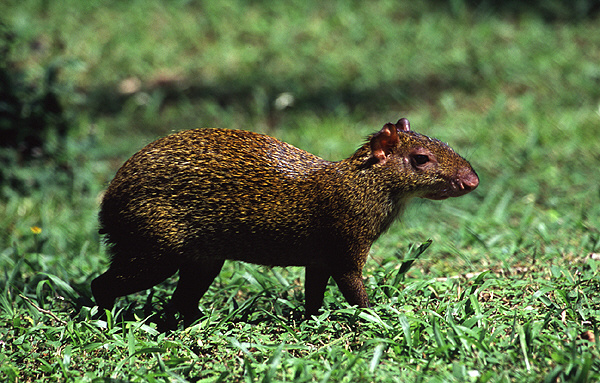
More about Agouti
Habitat
They can live in the driest deciduous forests to the wettest tropical evergreen forests.
Range
Agoutis can be found between southern Mexico and northern Argentina.
Physical Description
Within its range, the agouti is the most frequently found diurnal mammal in low-to-middle elevation rain forest. This small mammal is related to guinea pigs and chinchillas and is a relative of the paca. The agouti is reddish brown to black with a white, yellow, or gray underside.
Biology and Natural History
The agouti is diurnal unless it is too severely hunted; then it becomes more active at night. It is an important seed disperser for plants in its habitat: the agouti buries food in small caches that it will recover if fruit becomes scarce. If it does not return to these seeds, they may grow into plants and replenish the sources from which the agouti feeds. An agouti is capable of eating seeds with very hard seed coats, because while eating it may sit on its haunches in order to watch for predators-this gives it time to work on the seed. While sitting on its back legs, it can use its forepaws to hold the seed in place and gnaw on a specific spot.
One or two baby agoutis are born at a time in one of their mother's several sleeping spots. They are born extremely developed, and are very active soon after birth. Early in the morning on their first day, the mother takes them to potential nest sites dug by other animals, often consisting of crevices or burrows. The babies choose one site and prepare their own nest with leaves and twigs. Agoutis nest in homes too small for predators to enter-but this means the mother is also too large to enter the nest site. Instead, she calls the young in the morning and evening to feed.
These mammals communicate extensively through odor signals. For example, they mark their trails and feeding and sleeping spots by dragging odor glands across objects. Males will even mark potential mates by spraying urine on them as part of their courtship ritual (pacas do this as well). Adult males defend their territory to ensure the paternity of their offspring.
While agoutis are not necessarily antisocial, an individual agouti avoids any other agouti that walks directly toward it, because such an action is presumably provocative. To fight, agoutis of the same sex may run towards each other, leap just before they make contact, and kick each other with their strong hind legs, which can cause serious damage to both fighters. In the presence of predators, however, their main defense is to flee, as they repeat high-pitched barks to warn family within the territory. If they are directly encountered by a predator, they will raise hairs on the rump to appear larger; if a predator tries to bite this large tuft of hair, they will miss the skin of the agouti and it will have a greater chance of escaping.
Diet
Agoutis eat mostly fruit, including the seeds.
Height/Weight
Head and body length ranges from 41.5 to 62 cm; they weigh about 4 kg.
Taxonomy
Order: Rodentia
Family: Dasyproctidae
Sources
Eisenberg, John. Mammals of the Neotropics, Vol. 1. The University of Chicago Press: Chicago, 1989.
Smythe, N. in Janzen, Daniel H. Costa Rican Natural History. Chicago: University of Chicago Press, 1983.
Wilson, D. E. in Janzen, Daniel H. Costa Rican Natural History. Chicago: University of Chicago Press, 1983.
Amy Strieter, Wildlife Writer
Agouti Sightings
Similar Profiles
It's more than just having a good time or visiting beautiful places (although that's absolutely a part of it!), it's about being part of a unique experience that stays with you.



